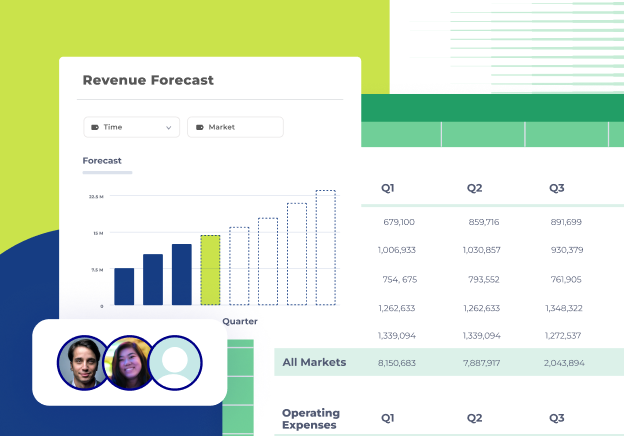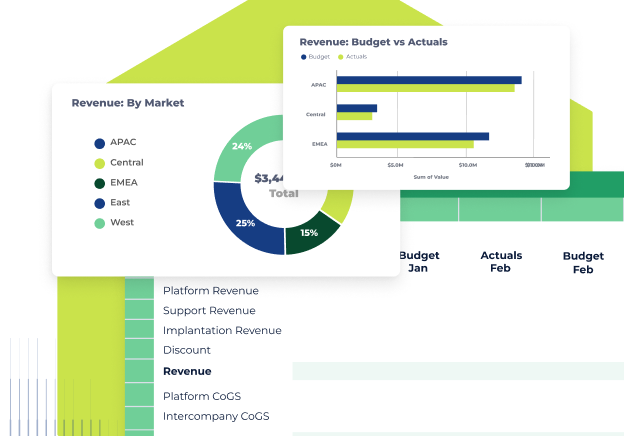Key takeaways on rolling forecasts
- Adopting a rolling forecast enables businesses to remain agile and flexible in their planning process and easily adjust to changing market conditions.
- Businesses need to establish KPIs like lead time accuracy, forecast bias, resource allocation effectiveness, variance, and forecast accuracy to monitor the quality of their rolling forecasts.
- Building rolling forecasts can be complex and time-consuming, but organizations can use forecasting software to automate forecast workflows and streamline their processes.
What is a rolling forecast?
Rolling forecasts are a flexible budgeting alternative to more static, fixed, or traditional forecasting strategies. In a rolling forecast, finance teams continually add on new periods as the current period expires, rather than setting a budget for a fiscal year and operating off of that budget regardless of changes to the business.
What's the difference between a rolling forecast and a traditional budget?
Understanding the differences between a rolling forecast and a traditional budget is crucial to decision-making. Traditional budgets may be suitable for small, stable businesses, but if your business operates in a volatile environment, you may find traditional budgets rigid and less useful for fast decision-making.
Rolling forecasts support continuous planning and are especially useful for fast-growing businesses operating in dynamic or unstable industries. Let’s look at the key differences between both in detail:
Static vs flexible
Traditional budgets are static budgets. They take a “set it and forget it” approach. They’re generally created towards the end of the prior fiscal year using data available at that time. From there, the budget remains unchanged for the next year. Static budgets can be helpful for organizations with stable or predictable revenue and expenses, as they provide clear targets and simplify financial planning. However, because of their inflexible nature, a traditional budget can become outdated and inaccurate within just a few months of rollout.
Rolling forecasts are quite flexible and businesses constantly update them with new information to reflect changing market conditions, trends, and new data. Rolling forecasts are particularly useful for dynamic and fast-growing businesses but they require more resources to maintain.
Level of detail
With traditional budgets, businesses tend to aggregate details, focusing on annual goals that are consolidated into financial targets such as overall revenue targets, capex, and expenses. Details concerning specific departments, product lines, or business regions if included are typically not granular. For example, the company may have a revenue target of $50 million for the year but not include a breakdown of revenue generation by department.
Rolling forecasts are frequently updated so they tend to have more details than traditional budgets. Rolling forecasts include monthly, quarterly, or yearly projections broken down by department, product lines, or teams. They include other details like key assumptions, KPIs, and variance analysis.
Variance analysis
Variance analysis in traditional budgets focuses on comparing actual performance against the fixed budget. This can happen monthly, quarterly, or yearly and businesses can apply these insights to the next planning cycle.
With rolling forecasts, variance analysis becomes an ongoing process. In addition to measuring actual performance against planned performance, businesses sometimes immediately adjust the forecast to reflect insights from the analysis.
Responsiveness to sudden market changes
Traditional budgets don’t respond to sudden market changes except in special situations. Businesses wait until their next planning cycle to revise plans to reflect changing conditions in the previous fiscal period.
People design rolling forecasts with the fact that market conditions can change in mind. Unlike traditional budgets, businesses update rolling forecasts monthly or quarterly to reflect what’s happening in the market such as consumer demand and economic downturns. It uses a proactive approach that enables businesses to maintain better control over financial plans.
How do businesses overcome this challenge? Enter: the rolling forecast
As a business evolves, a rolling forecast evolves with it. It’s a living, breathing document that is always updated for a set timeframe, such as 12 months out, with most companies rolling it forward each month or quarter. Forecasting compliments the budget by consistently evaluating projections based on the most up-to-date information.
Some companies may not realize they already have a rolling budget. It’s just buried in that “master Excel model” on someone’s desktop that’s updated every time the business identifies a major change.
As an example, take the COVID-19 pandemic. Suppose a company in the restaurant supply industry, perhaps a large restaurant supplier, created its budget in October 2019.
In 2020, they likely expected to see business as usual or even steady growth. Once March of 2020 came about, all of that changed and it was unlikely that their budget had any ground to stand on. Their business would have likely failed if they had stuck to their original budget and continued spending resources as initially planned.
Instead, creating a forecast and updating it with industry data as it changes throughout the year would have allowed that company to shift its focus and reallocate resources as needed. The rolling forecast budget would be the ultimate saving grace for the business.
While COVID-19 was an outlier, every business can benefit from forward-looking data and accurate projections throughout the year.
Why businesses use rolling forecasts
Here are a few reasons why finance leaders are opting for rolling forecasts:
Adapt to changes
Rolling forecasts allow businesses to review original budgets and adjust based on current market conditions. Instead of relying solely on a static budget to guide their decisions, leadership can react to the fluctuations or uncertainty that may be driving the economy and industry.
A good example of a rolling forecast is a company setting a sales target of $50,000 in January and adjusting it every month as new sales data becomes available. With accurate and updated data, companies can determine if they need to reallocate company resources to stay on track.
Make informed decisions
An updated quarterly or monthly forecast allows business leaders to make strategic decisions with the best information available. Rolling forecasts allow leadership to quickly adjust spending in response to current market data. This creates a better financial planning process and helps the company stay ahead of the curve while they navigate economic changes.
Set realistic goals
Since it’s an ever-evolving document with regular updates, a rolling forecast creates an easy way to maintain a realistic set of strategic goals. As new information becomes available, the team can reassess and adjust goals to reflect what the company can achieve.
A rolling forecast budget can keep the company moving toward success even if the targets shift along the way.
Key performance indicators (KPIs) for monitoring rolling forecasts
Monitoring specific KPIs provides organizations with valuable insights into their rolling forecasts’ accuracy and reliability. Here are some of the key KPIs to monitor:
Lead time accuracy
Lead time accuracy evaluates the effectiveness of forecasting methodologies in providing timely and actionable insights. It guides decision-making by assessing the reliability of forecasts over different planning horizons, ensuring that organizations can make informed decisions based on reliable projections. Consistent lead time accuracy ensures businesses are better prepared for unexpected market changes and can respond proactively
Forecast bias
Forecast bias helps identify systematic errors or biases in the forecasting process that the business may need to correct. By adjusting for biases, organizations can improve forecast accuracy and align projections more closely with actual outcomes, leading to more reliable and effective decision-making. Eliminating forecast bias fosters a more objective view of future performance, minimizing risks and enhancing strategic planning.
There are many ways to measure forecast bias, but one common method is using this formula:
Forecast Bias = (Forecast / Actual Result) × 100
This expresses forecast bias as a percentage. A result close to 100% indicates minimal bias, meaning the forecast closely matches the actual result. Values above 100% suggest the forecast overestimated the actual result, while values below 100% indicate an underestimation.
Resource allocation effectiveness
Resource allocation effectiveness determines whether resources are optimally allocated to support strategic goals and operational requirements. Accurately assessing resource allocation effectiveness helps avoid bottlenecks and ensures critical projects receive needed attention. You can measure resource allocation effectiveness by establishing KPIs such as cost per unit, productivity, utilization rates, and time to complete projects using internal historical data or industry benchmarks. Set targets and compare actual resource allocation to check if you used resources properly.
Variance analysis
Variance analysis helps identify areas of performance deviation and understand the reasons behind discrepancies. It encourages course correction for future forecasts and improves the accuracy and reliability of forecasting processes. Regular variance analysis allows for dynamic adjustments, keeping the business on track toward its financial and operational goals.
Forecast accuracy
High forecast accuracy signifies the reliability and precision of the rolling forecast budget. This accuracy helps organizations make informed decisions based on trustworthy projections. Improving forecast accuracy also builds organizational confidence in financial projections, driving better stakeholder engagement and long-term planning.

How to develop and manage a rolling forecast
Setting up a rolling forecast can be daunting. That's why we simplified the process into 9 simple steps. Rolling forecast best practices include:
1. Determine the end goal
Creating a rolling forecast is similar to undergoing any other planning process. Start by establishing an end goal and objectives for the overall business, departments, and teams, like:
- Reducing operational costs
- Driving growth
- Increasing sales by 20%
- Optimizing inventory levels
- Improving cash flow
Specifying objectives helps the finance team decide the purpose and direction of the forecast. For example, if the objective is to increase sales by 20%, the rolling forecast will identify sales trends, project revenue growth, break down sales targets by product lines, etc.
Your finance teams can then navigate the next several forecasting steps with clarity on what the business wants to achieve, making it easier to prioritize.
2. Set the horizon and increments
A rolling forecast’s horizon decides how far the forecast projects data into the future while increments determine how often the business rolls forward forecasts. The dynamic nature of a business combined with a company’s sensitivity to market conditions decides both the time horizon and increments for a rolling forecast.
For example, a cell phone provider may not experience significant fluctuations during economic shifts since most people consider their service essential. However, a meal subscription service may face greater volatility as consumers look for ways to manage expenses when finances become uncertain. In this case, the cell phone provider might not need to update forecasts as frequently as the meal subscription service.
3. Decide on the detail level
Each company has a unique perspective on how detailed a forecast should be. The level of detail should depend on how detrimental a poor decision based on bad data would be to the company.
If there’s a high risk of significant consequences, the data must be as accurate and detailed as possible. While this can be more time-consuming for the finance team, it will undoubtedly help the company move closer to its strategic goals.
4. Engage key contributors
A rolling forecast’s success is only as good as the data that goes into it, like its drivers and assumptions. The best people to provide updates to drivers and assumptions? Managers and key contributors to the organization. The finance team should take the time to include key stakeholders in the forecasting process and provide a clear set of templates and process guidelines for those contributors.
5. Identify quantitative and non-quantitative assumptions
The rolling forecast process should provide more interpretive data than a static annual budget. Where a budget might list thousands of lines of historical data, forecasts need only focus on what pieces of the business are most impactful—these are often referred to as key drivers and assumptions.
Rather than dive into how many pens to purchase for the office in a given quarter, leadership may want to know how many new subscriptions for their service or what the price per unit was for a product.
6. Gather the data
Rolling forecasts generally start with a fully completed budget. Budgets are a starting point and reference to roll out the first new forecast. Forecasts use the actual figures from each forecast period and are typically rolled every quarter unless the business or market changes rapidly enough to justify a monthly update.
When gathering the data for the forecast, it’s important to thoroughly vet each source. Industry statistics and developments will inform projections. Rather than relying on any random source, work to utilize credible information verified by industry leaders to ensure a quality forecast and alleviate the risk of poor decisions.
7. Establish scenarios
The best part of a rolling forecast is the ability to consider a wide array of scenarios and what-if analysis tests. Using different scenarios, FP&A teams can project a range of possibilities and determine their impact on company finances. Each time the business rolls forward the forecast, they can tweak the scenarios and adjust using the newest information available.
One best practice is to have an ever-evolving “base case” forecast. The organization can then copy and save the “base case” when locking a rolling forecast. For example, if the company forecasts monthly, they would copy the base case at the end of each month for the January forecast, February forecast, March forecast, etc.
8. Institute a regular variance analysis process
Sometimes referred to as “performance management,” tracking actual performance and comparing it to the forecasted data on a regular basis will help leadership understand which targets they met or not and why it happened. This is variance analysis. Leadership can make a more reliable projection for the next forecast using that information.
Variances are a normal part of forecasting. What’s important is that finance reflects on the reasons for the variances and what to do about the future and then pivots to accommodate those answers. Then, analyze the variances for both failures and successes.
9. Course correct
Each time a variance is found and the forecast shows a different result than initially projected, it’s important to course correct. This agility helps the company overcome its challenges and prepare for what is likely to occur. Course-correcting can often involve cutting costs in one area to double down or reallocate resources to a different area of the company.
Navigating the challenges of implementing rolling forecasts
Let’s explore the common obstacles organizations encounter when implementing rolling forecasts and how to overcome them.
Addressing cultural resistance
Overcoming cultural resistance requires a concerted effort to foster a culture of openness, collaboration, and continuous improvement within the organization. Effective communication and stakeholder engagement are paramount in gaining buy-in for rolling forecasts. Providing comprehensive training and education on the advantages of rolling forecasts can help assuage concerns and instill confidence in the new approach.
Confronting data quality challenges
To mitigate data quality issues, organizations must prioritize investments in robust data governance processes and technologies. Establishing clear data standards, conducting regular audits, and leveraging data validation tools are crucial steps in enhancing the accuracy and reliability of data used in rolling forecasts.
Complexity of implementation
Organizations should develop a clear implementation plan with defined milestones, roles, and responsibilities. Leveraging external expertise or partnering with consultants who specialize in rolling forecast model implementation can also provide valuable guidance and support.
The best software for managing rolling forecasts
While static budgets may be easier to maintain, rolling forecasts better reflect the reality of the financial health of a company. However, the rolling forecast model can be more difficult to maintain since it requires consistent updates and upkeep. To that end, many FP&A teams use tools and software to minimize the manual work needed to maintain an accurate and effective rolling forecast.
1. Cube

Cube is a cloud-based FP&A platform that helps companies hit their numbers without having to sacrifice their spreadsheets. Cube’s AI-powered platform works right in Excel and Google Sheets to eliminate the inefficiencies and complexities often associated with traditional FP&A tools.

Cube’s forecasting tool enables users to create accurate forecasts and projections by identifying trends, challenges, and growth opportunities based on historical data. It provides a spreadsheet-first experience for users, turning Excel from a simple tool to a complete financial forecasting software using advanced features like AI-powered forecasting, customizable dashboards, version controls, and more. With Cube, businesses can build confidence with investors, set precise goals, and optimize operational plans.
For rolling forecasts, Cube customers take advantage of scenario duplication and lock capabilities to retain prior scenarios for reference and reporting. For the new forecast, Cube will actualize your most recent month for you. You’ll spend your time managing the forecast and your plan for the new month that rolled into your forecast–not manually wrangling data.
Take your rolling forecasts to the next level with Cube. Book a demo today.

2. Vena Solutions

Vena Solutions is a financial planning and analysis software that natively integrates with Microsoft 365. It offers AI capabilities that enable users to build flexible data models and forecasts and automate repetitive tasks.

Its rolling forecast platform allows users to bring all their business data into a single source of truth, make top-down adjustments to forecasts, and model scenarios to show the impact of financial projects and revenue forecasts.
Vena also enables users to automate forecasting workflows and map out processes like creating reminders of forecast reviews and approvals, automatically sharing templates, reports, and more.
3. Workday Adaptive Planning

Workday Adaptive Planning offers AI and ML-powered enterprise performance management (EPM). It supports workforce planning, operational planning, close and consolidation, and financial planning.

Its financial planning module provides a budgeting and forecasting tool that allows businesses to build rolling forecasts and respond to variances in real time. The platform lets users build daily, monthly, or quarterly forecasts. Users can also create multiple what-if scenarios based on forecasts and real-time data. Workday offers integrations with backend solutions so businesses can import their ERP data and keep forecasts up to date.
4. Anaplan

Anaplan enables businesses to connect their finance, sales, supply chain, and workforce plans. It provides a connected system for storing all business data. Its financial forecasting platform leverages AI and ML capabilities to streamline businesses' revenue, opEX, headcount, capital, and long-range planning. It offers embedded algorithms that support statistical forecasting, such as seasonal smoothing and curve fit.

Businesses use Anaplan to link financial, sales, and operational forecasts and update them from a single data source. Users can forecast daily, weekly, monthly, or yearly and build and compare scenarios to make informed decisions.
5. Planful

Planful is a financial performance management software for finance, accounting, marketing, HR, sales, IT, and operations teams. It supports scenario planning, analysis, budgeting, and forecasting.

Its rolling forecasts platform enables users to build and adapt forecasts as the business changes. Users can continuously adjust key drivers over a 12-month period to reflect market shifts and changes. Planful users can also automatically assign responsibilities, track submission status, send updates with action items to stakeholders, and collaborate in real-time.
Keep your rolling forecasts rolling
Creating and implementing a rolling forecast is the perfect complement to the traditional budgeting process. While a static budget can provide the detail behind each line item, a rolling forecast model offers projections based on current business data and market trends. It allows companies to react to their environments quickly while upholding realistic goals.
While many companies fail to implement this living document due to its complexity and time commitment, those that do are in an exponentially stronger position to succeed. With some extra attention, a rolling forecast can help companies hit the mark and realize their strategic goals more consistently.
Companies can use Cube to simplify and automate the complexities of rolling forecasts, making it easier to update projections and stay aligned with real-time business data. Ready to see the difference for yourself? Reqyest a Cube demo today.




.png)









.png)

.webp)






![The 9+ Best OnPlan Alternatives and Competitors [for 2024]](https://www.cubesoftware.com/hubfs/OnPlan%20Alternatives%20ft%20image.png)
![12+ Best FP&A software for small businesses [2025]](https://www.cubesoftware.com/hubfs/EBook%20Cover%20(33).png)
![14 best budgeting software tools & apps [updated for 2024]](https://www.cubesoftware.com/hubfs/Best%20Business%20Budgeting%20Software%20Tools%20(1).png)